
Triceratops is one of the most iconic dinosaurs to ever roam the land. Built like a tank and armed with three massive horns, the triceratops has fascinated scientists and laypeople alike. Let’s see what makes it so special and remarkable.
The Three-Horned Dinosaur
Triceratops is hard to mistake for any other animal. The dinosaur has three massive horns, a frilled collar, and a robust body that stomped across the ancient lands. It measured 8–9 meters (26–30 ft) long and weighed 5–9 metric tons.
Its name, triceratops, literally means “three-horned face” — how fitting. Two large, sweeping horns adorn the forehead, while a smaller horn protrudes from the snout. But why three horns? Experts believe they served as formidable weapons against predators and possibly played a role in mating displays.
Chewing, defending, and dueling
The first theory for the triceratops‘ horns is, obviously, defense. This was backed up by some fossil findings, particularly a handful of fossils that show injuries caused by T-Rex to triceratops and vice versa. A fossil showing a triceratops and a T-Rex in combat went on public display for the first time in 2020 — so at least occasionally, the horns were used for defense. But was this the main function?
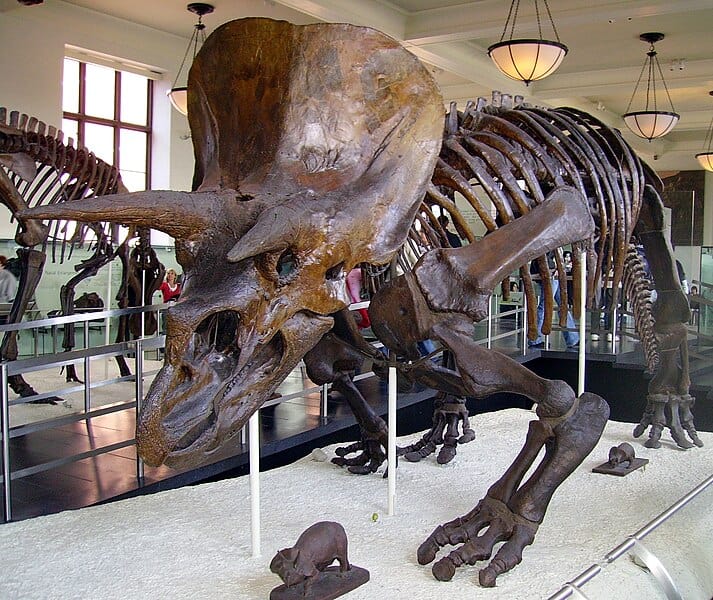
Another hypothesis was proposed by paleontologists several times: that of chewing. Essentially, the idea is that the horns allow the jaw to grow bigger muscles. This enables the dinosaur to chew harder, opening up a more varied menu. But more recent studies have found no evidence of said muscles. So this once popular idea seems less convincing now.
Another idea that’s often represented in media is triceratops engaging each other in combat, horns locked. Studies show that something like this is feasible. Furthermore, some fossils have shown signs of damage that are consistent with dueling. But this is still not clearly settled. Other studies suggested that the damage is caused by a bone disease, while one study suggested bone diseases couldn’t have been responsible, and the debate is still ongoing.
“Paleontologists have debated the function of the bizarre skulls of horned dinosaurs for years now,” said Andrew Farke, curator at the Raymond M. Alf Museum of Paleontology. “Some speculated that the horns were for showing off to other dinosaurs, and others thought that the horns had to have been used in combat against other horned dinosaurs. Unfortunately, we can’t just go and watch a Triceratops in the wild.”
At any rate, the triceratops horns seem to have been multifunctional. It’s not clear exactly why the horns evolved, but they are still the dinosaur’s most prominent feature.
“No frills” is not for triceratops
Perhaps one of the most distinctive features of the triceratops, aside from its three pronounced horns, is the large bony frill that extends over its neck. Their frills were also theorized to have a number of purposes, like the horns. These purposes range from defense, species identification, cooling, and mating display.
Much like a peacock’s colorful tail or a lion’s majestic mane, the triceratops’ frill might have played a part in mating displays or in distinguishing one individual from another. Each triceratops could showcase how awesome they are by showing off this feature.
Alternatively, the frill could have been a defensive tool. The defense purpose is fairly obvious. If the horns act as a weapon, the frills are a shield or armor to protect the vulnerable neck.
However, some studies have suggested that the frill may have been more than just ornamentation or armor. The study authors propose that it could have been involved in regulating body temperature, acting like a radiator to release heat. Ultimately, though, the frills may have served multiple purposes, and the jury is still out on what exactly they did.
Convergent evolution and rhinoceros

Standing before the reconstructed skeleton of a triceratops in a museum, you might be struck by its formidable and robust structure. Even among dinosaurs, the triceratops was indeed a heavyweight. Interestingly, there’s a creature in today’s time that closely resembles some of the triceratops traits: the rhinoceros.
Although the rhinoceros is a mammal and the triceratops is a dinosaur, the two bear striking similarities. The two animals are not related. They just evolved similarly. Scientists call this process “convergent evolution.”
Convergent evolution occurs when unrelated species develop similar physical characteristics due to similar environmental pressures or needs, not because of a shared lineage. In the case of the triceratops and the rhinoceros, both needed powerful bodies to support massive heads and to deter predators.
Triceratops History
To reach triceratops, you’d have to journey back into the past some 68 million years ago.
Not a Jurassic Dinosaur
The triceratops roamed the Earth around 68 to 66 million years ago, during a period called the Late Cretaceous. This is the last part of the Mesozoic, right before the dinosaurs went extinct. Yep, despite what some media would have you believe, triceratops (and the T-Rex) are not really Jurassic dinosaurs. The Jurassic period happened tens of millions of years earlier.
During the Cretaceous period, the world was a vastly different place. For starters, the continents looked nothing like they do today. That’s because the planet’s tectonic plates are constantly on the move and the continents are drifting. It’s not just the continents that were different — the climate and environment were different too.
The climate during the Late Cretaceous was warmer and more humid than today. There were no polar ice caps, and sea levels were higher. Tropical and subtropical conditions prevailed in many regions, giving rise to lush forests and extensive wetlands.
Picture a world without winter, where verdant vegetation feeds colossal creatures, and the triceratops ambles through dense ferns and towering conifers. Dinosaurs were the dominant land animals, and the triceratops shared its world with other famous giants like the T-Rex and the hadrosaurs.
Triceratops fossils
Researchers have named at least 17 triceratops species. However, just two of them are now currently considered true triceratops. As more studies come in, our understanding of them improves.
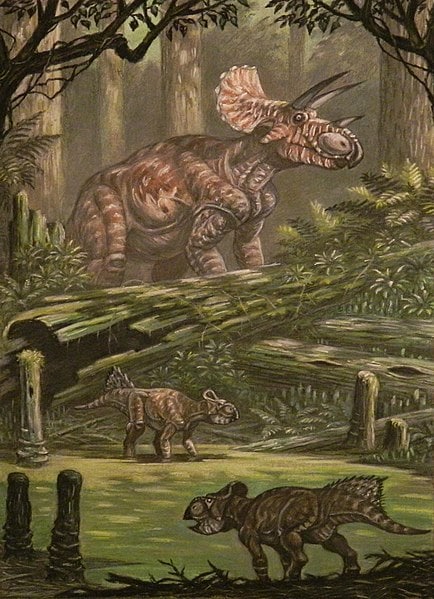
The first triceratops fossil was found in 1887, and initially, paleontologists thought it belonged to a bison. Overall, paleontologists have unearthed over fifty complete triceratops skulls. What’s more, they’ve pieced together a history that’s both fascinating and dynamic.
We also know that triceratops had around 800 teeth. These teeth were constantly replenished, with new ones coming in. These teeth were arranged in groups called batteries, each having around 40 teeth on each side of the jaw. This enabled the triceratops to munch on a variety of plants ranging from ferns and cycads to the occasional root and conifers.
“If you took these dinosaurs’ teeth and put them in a cow for example, they would work,” said Gregory Erickson, a biology professor at Florida State University.
Paleontologists are still debating exactly what species are triceratops, and whether other species could fall into this group as well. Characterizing and defining these dinosaurs is not an easy task, particularly as other dinosaurs share some of its similarities.
Dinosaurs Like Triceratops
Triceratops wasn’t alone in its horned splendor. Dinosaurs like triceratops were part of a group known as ceratopsids.
Ceratopsids, or horned dinosaurs, are characterized by their elaborate frills, beak-like mouths, and often impressive horns. They thrived in the Late Cretaceous period, roaming the lands of what is now North America and Asia.
Some, like the styracosaurus, had spikes radiating from their frills. Others, like the pint-sized protoceratops (that measured less than a meter high), were a more modest affair, lacking the grandiose horns but still retaining the family resemblance. All of these walked on four legs, had a bulky build, and had massive frills and horns. Ceratopsian dinosaurs were herding animals and all lived in the late Cretaceous. They were also all herbivorous.
Ceratopsids all consume high-fiber plant material with their highly derived dental batteries and advanced dentition. They may have utilized fermentation to break down plant material with gut microflora. Here are some examples of ceratopsids, or dinosaurs that look like triceratops but are not.
Torosaurus
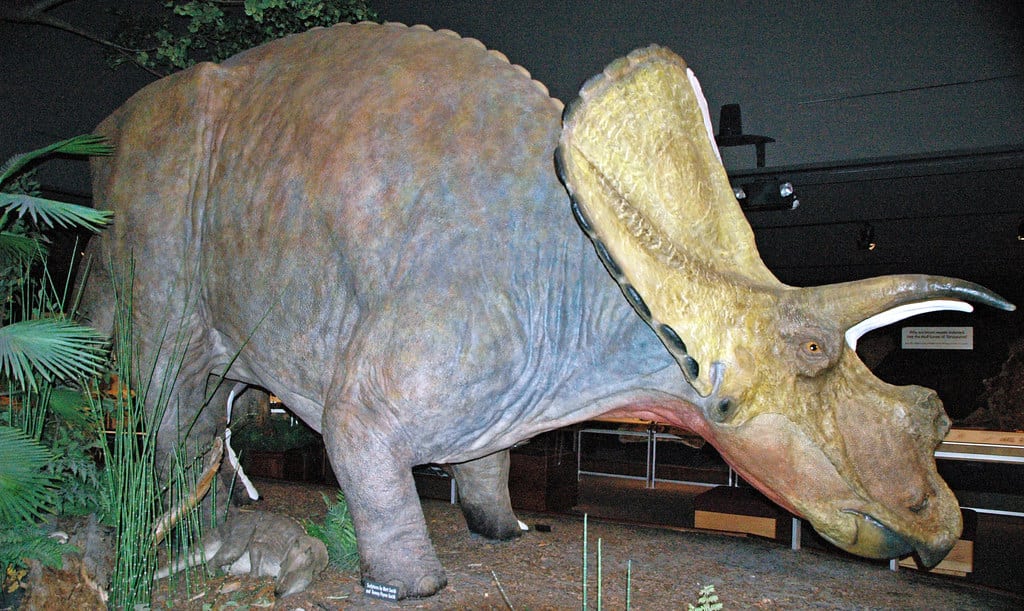
The torosaurus, with its enormous frill containing large openings, stands out among its kin. Some scientists have even debated whether torosaurus and triceratops are actually different growth stages of the same species.
Imagine a triceratops with an even more expansive and delicately structured frill. The torosaurus is distinguished from the triceratops by an elongated frill with large openings.
“If Torosaurus is actually the mature form of Triceratops, we must ask why ‛Torosaurus’ specimens are relatively rare compared to Triceratops,” said John Scannella, a Montana State University paleontologist. “It is possible that mortality was fairly high for Triceratops before they reached their fully mature morphology.”
Kosmoceratops
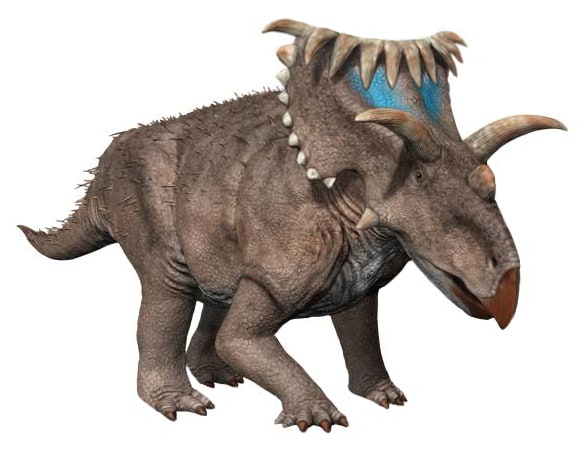
The kosmoceratops is undoubtedly one of the most ornate members of the ceratopsid family. In fact, its name means “ornate horned face.” Kosmoceratops had an estimated length of 4.5 m (15 ft) and a weight of 1.2 t (1.3 short tons).
They roamed the land a bit earlier than the triceratops, some 76 million years ago.
Pachyrhinosaurus
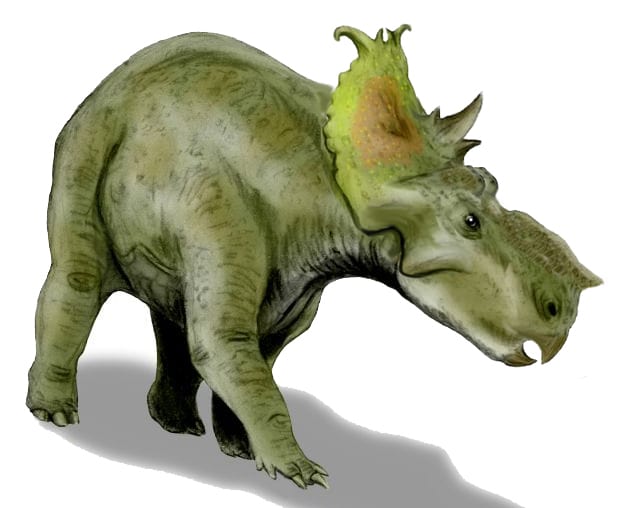
Unlike its relatives that sported prominent horns, pachyrhinosaurus had large, bony masses on its nose and above its eyes. It’s a prime example of how diverse the ceratopsid family truly was. During the first few years of development, the species exhibited extremely rapid growth. When the animals were one year old, they had already reached 28% of their adult body size. By age two, they were almost half the size of a mature adult.
Imagine a triceratops trading its signature horns for thick, bumpy structures. That’s the pachyrhinosaurus, a dinosaur that challenges our conventional ideas about horned dinosaurs.
Achelousaurus
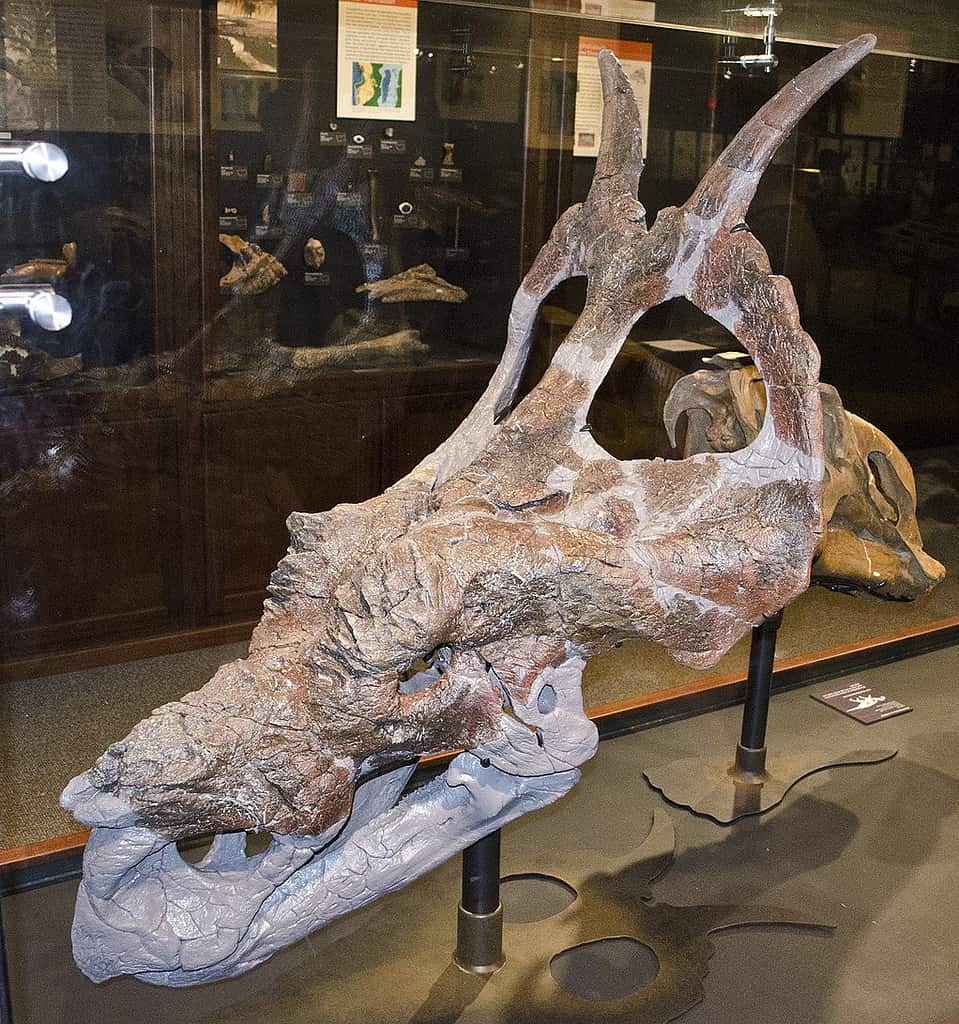
The achelousaurus is unique in that it had rough bosses, or large bony structures, instead of horns. Some scientists speculate that these features might represent scars from battles over territory or mates.
The genus is known from a few specimens consisting mainly of skull material from individuals.
Stegosaurus, Triceratops, and T-Rex
You’ve undoubtedly heard of the stegosaurus and T-Rex, two other iconic dinosaurs from the Mesozoic era. But how do they relate to the triceratops?
Well, the stegosaurus lived around 150 million years ago, far earlier than the triceratops. Its leaf-shaped plates and spiky tail are easily recognizable but represent a different chapter of dinosaur evolution. In fact, the stegosaurus is the only true Jurassic dinosaur of the three — the triceratops and T-Rex lived in the late Cretaceous, millions of years later. So there’s no way these three dinosaurs could have met up.
However, the terrifying T-Rex was a contemporary of the triceratops. Fossils suggest they likely crossed paths, leading to dramatic confrontations that have ignited the imaginations of many.
These three dinosaurs, though different in appearance and time, represent some of the most captivating creatures that ever walked the Earth.
Picture a face-off between these two titans. The triceratops, with its armored frill and horns, could likely fend off the fierce bite of a T-Rex. It’s a battle of brute force and sharp wit, with both creatures vying for survival in a world long lost to time.
Fascinating Triceratops Facts
To better acquaint you with this three-horned wonder, here’s a collection of intriguing facts:
- Horns and Frills: The triceratops had two large horns above its eyes and a smaller one on its nose, along with a large bony frill at the back of its head.
- Size: Adult triceratops could grow up to 30 feet in length and weigh as much as 12 tons.
- Diet: It was a herbivore, feasting on plants like ferns and cycads.
- Habitat: Lived in the late Cretaceous period, around 68 million years ago, in what is now North America.
- Family: Part of the ceratopsid family, which included other horned and frilled dinosaurs.
- Defense: Its horns and frill likely served as defense mechanisms against predators like the T-Rex.
- First Discovery: The first triceratops fossil was discovered in 1887 by Othniel Charles Marsh.
- Extinction: Triceratops, along with other non-avian dinosaurs, became extinct around 66 million years ago.
Triceratops FAQ
The name Triceratops means “three-horned face,” derived from the Greek words “tri” (three), “kératos” (horn), and “ops” (face). It refers to the three distinct facial horns that characterize the species.
Triceratops fossils are mainly found in North America, particularly in the U.S. states of Wyoming, Montana, South Dakota, and Colorado.
Triceratops were herbivores, and their diets likely consisted of low-lying plants such as ferns and cycads. Their beak-like mouths were adapted for clipping plants, while their teeth were used for grinding.
Adult Triceratops could grow up to 30 feet (9 meters) in length and weigh around 12 tons. Their skulls alone could measure up to 6.5 feet (2 meters) in length.
The primary predator of the Triceratops was likely the Tyrannosaurus rex. Triceratops’ horns and frill might have been used as a defense mechanism against such predators.
The frill, a bony plate at the back of the head, may have served multiple purposes, including protection, mating displays, or body temperature regulation. The exact function is still debated among scientists.
Triceratops and Torosaurus are closely related, and some paleontologists have even proposed that they might be the same species, with Torosaurus representing a more mature form. This theory, however, is controversial.
Some fossil evidence suggests they might have traveled in herds, but more research is needed.
The two longer horns above the eyes could grow up to 3 feet (1 meter) in length, while the smaller nasal horn was shorter and more conical. Some variation in horn shape and size is seen among different Triceratops fossils.
Despite being one of the most well-known and extensively studied dinosaurs, there is still much to learn about Triceratops. Ongoing research continues to uncover new insights into their behavior, physiology, and ecology, ensuring that the Triceratops remains a captivating subject for paleontologists and dinosaur enthusiasts alike.
Fossil evidence shows that triceratops and T-Rex did have confrontations, and it’s likely that the triceratops’ horns served as a defense against the predatory T-Rex.
Researchers have named at least 17 triceratops species, but currently, only two are considered true triceratops.
The first triceratops fossil was discovered in 1887 by Othniel Charles Marsh, who initially thought it belonged to a bison.
Its large horns and bony frill likely served as defense mechanisms against predators. The horns could be used to gore predators, while the frill protected the neck area.
Triceratops skeletons are exhibited in many natural history museums around the world, including the Smithsonian National Museum of Natural History in Washington, D.C., and the American Museum of Natural History in New York City. Most large natural history museums have triceratops fossils or at least some cast.
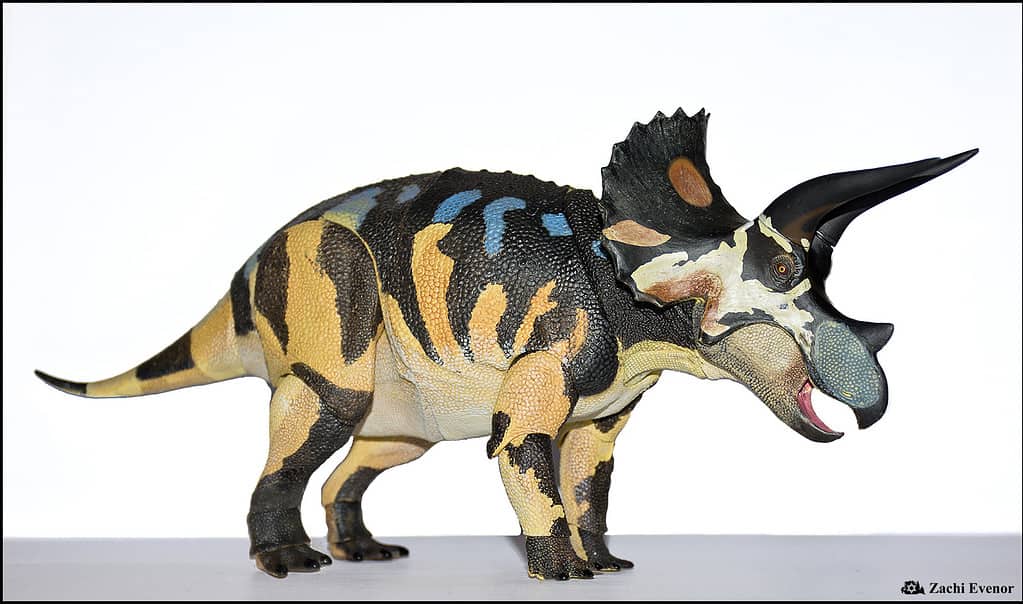
An impactful legacy of an iconic dinosaur
Though the triceratops vanished from the Earth around 66 million years ago, its legacy endures. From its striking horns and intricate frill to its robust build and the still-mysterious functions of its most distinctive features, the triceratops continues to capture our imagination.
In museum displays, movies, literature, and art, this dinosaur has become an emblematic representative of a bygone era. The discovery and study of its fossils have not only revealed insights into this particular species but have shed light on an entire family of horned dinosaurs and the fascinating phenomenon of convergent evolution.
As scientists continue to unearth more fossils and develop new methods of studying these ancient creatures, our understanding of triceratops and its world will likely grow richer and more complex. There’s a strange beauty in the fact that a creature from millions of years ago still generates wonder, curiosity, and debate in the modern world.


